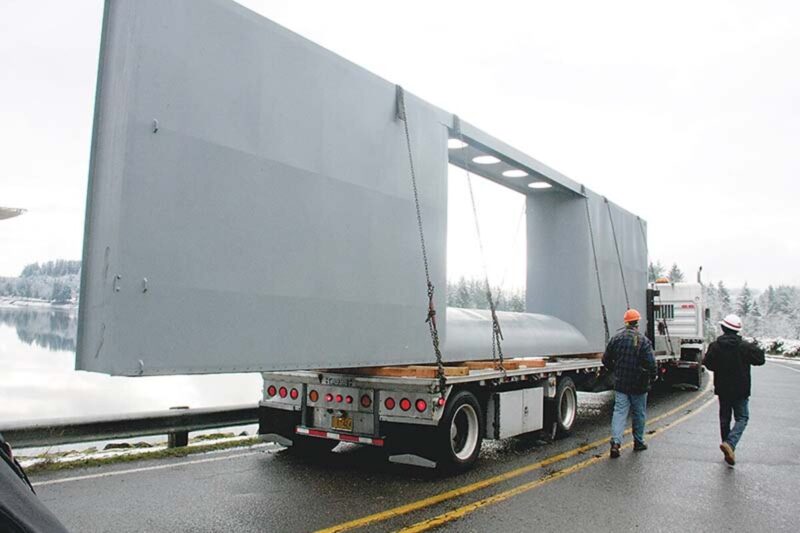Sean C. Morgan
The U.S. Army Corps of Engineers began installing a new fish weir in Foster Dam last week that is expected to help improve the chances of survival for hundreds of thousands of spring Chinook salmon and winter steelhead traveling downstream.
The Corps had planned for the project to be complete Thursday, Feb. 22, but workers were stopped short when a piece of wood debris prevented a crane from detaching completely from a new stop log behind the southernmost spillway gate. Corps divers located the wood debris Friday.
Public Affairs Specialist Tom Conning said the Corps plans to finish the project this week, but a time and date had not been set as of press time.
The $400,000 project replaces a weir that provided a 200- to 250-cubic-feet-per-second of flow from Foster Lake into the South Santiam River below.
A weir constrains the release of water to maintain flow requirements, attracting fish with a stream-like flow from the surface of the reservoir and creating a cushion of water when they land on the spillway at the base of the dam, Conning said. The cushion makes the fall from the reservoir less harmful for the fish.
“This new fish weir has a new range of 300 to 800 cfs,” said Corps Fish Biologist Fenton Khan. It will be maintained at 500 cfs.
With a lower flow, the old weir had a steeper fall at the spillway and a smaller cushion of water, compared to the new weir.
The Corps installed the old weir in 1984 to help improve downstream passage for juvenile salmon and summer steelhead, Khan said. The Corps used the weir for about one month each year in the spring until 2012.
Its use of the weir changed after the National Marine Fisheries Service issued a new biological opinion in 2008.
Among actions recommended in the opinion was the improvement of downstream passage at Foster Dam, Khan said. The Corps has been conducting research at the dam since 2012 to determine the best way to move the fish downstream at the dam.
Researchers sent sensor “fish” through the power generation turbines at the dam and over the weir at different pool levels to measure the forces affecting the fish as they travel past the dam. The data told researchers that using the weir had the lowest mortality and injury rates.
Since then, the Corps has been using the weir throughout the entire year, Khan said. After moving to full-time use of the weir, the Foster Lake Pool has run about 2 feet lower than normal.
Khan said that the Corps could not have done this project without the support of Linn County Parks Director Brian Carroll. The Corps worked with him to adjust boat ramps for recreational use and to help explain to the public what is happening and why.
The City of Albany also was critical, opening its dam in Lebanon to allow the Corps to install additional research equipment there, Khan said.
Data from research at the dam informed scientists that the Corps needed to build a new weir because the existing one was not very efficient at moving fish, Khan said. Fish were still finding their way into the turbines, and he and Corps engineers went to work designing a new weir.
It had to be shaped to attract fish better and provide a higher flow rate to improve the cushion of water on the spillway, Khan said. Salmon, and especially steelhead, are surface-oriented fish and the motion of the water caused by the weir will encourage them to use the weir instead of the turbine inlet.
Although the turbine inlet is below the surface of the reservoir, fish would detect its higher flows instead of the flow created by the old weir, Khan said.
The new weir will sit on three new stop logs, which help maintain pool elevation. The weir itself is 47 feet long, about 10 feet tall and 3 feet 7 inches thick. The stop logs and weir fit in slots in the spillway through an opening in Foster Dam Road.
Khan said that the number of Chinook returning to spawn in the South Santiam is “doing OK,” but the number of adult winter steelhead has continued to drop.
The Corps used to see 600 to 700 of them returning each season to the South Santiam River, Khan said. Currently, estimates are around 20 to 50.
They are assisted upstream by a facility below the dam where they are collected and taken further upstream by truck.
In addition to juvenile fish, the weir also will assist adult steelhead, Khan said. Unlike salmon, the adults return to spawn and go back to the ocean multiple times in their lives.





